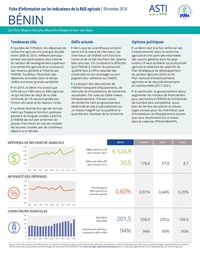Authors:
Léa Vicky Magne Domgho, Marcellin Allagbe and Gert-Jan Stads
Year:
2018
Publisher
International Food Policy Research Institute and Institut National des Recherches Agricoles du Bénin
Back to:
Key trends
- Agricultural research expenditures nearly doubled between 2000 and 2016 (in inflation-adjusted terms), largely driven by greater involvement in agricultural research by the higher education sector and growth in INRAB’s internally generated revenues. Yearly spending levels were rather variable over time, however.
- In 2016, Benin invested just 0.6 percent of its AgGDP in agricultural R&D, which is well below the 1 percent minimum target recommended by the African Union and the United Nations.
- A long-term civil servant recruitment ban was recently lifted, allowing INRAB to recruit and train young researches after years of capacity losses due to retirement.
Current challenges
- Unlike their university-based colleagues, INRAB’s scientists are classified as public servants, not researchers, so their salaries are much lower. This, combined with universities’ benefits associated with membership in CAMES (francophone Africa’s higher education council), make it hard for INRAB to compete for qualified staff.
- Most of INRAB’s laboratories lack up-to-date research equipment and facilities, and the number of vehicles is inadequate. With low levels of capital investment, research infrastructure has deteriorated over time, understandably having negative impacts on the quality and quantity of research outputs.
Policy options
- Benin needs to increase its own investment in agricultural research and take advantage of knowledge spillovers from neighboring countries in order to accelerate agricultural productivity to reach the goals defined in its Strategic Development Plan for the Agricultural Sector 2025 and its National Agricultural and Food Security Investment Plan (2017–2021).
- In particular, the government will need to increase funding levels to enable INRAB to operate more competitively, both in terms of researcher salaries and benefits, and facilities and equipment (other than those recently upgraded under WAAPP).

